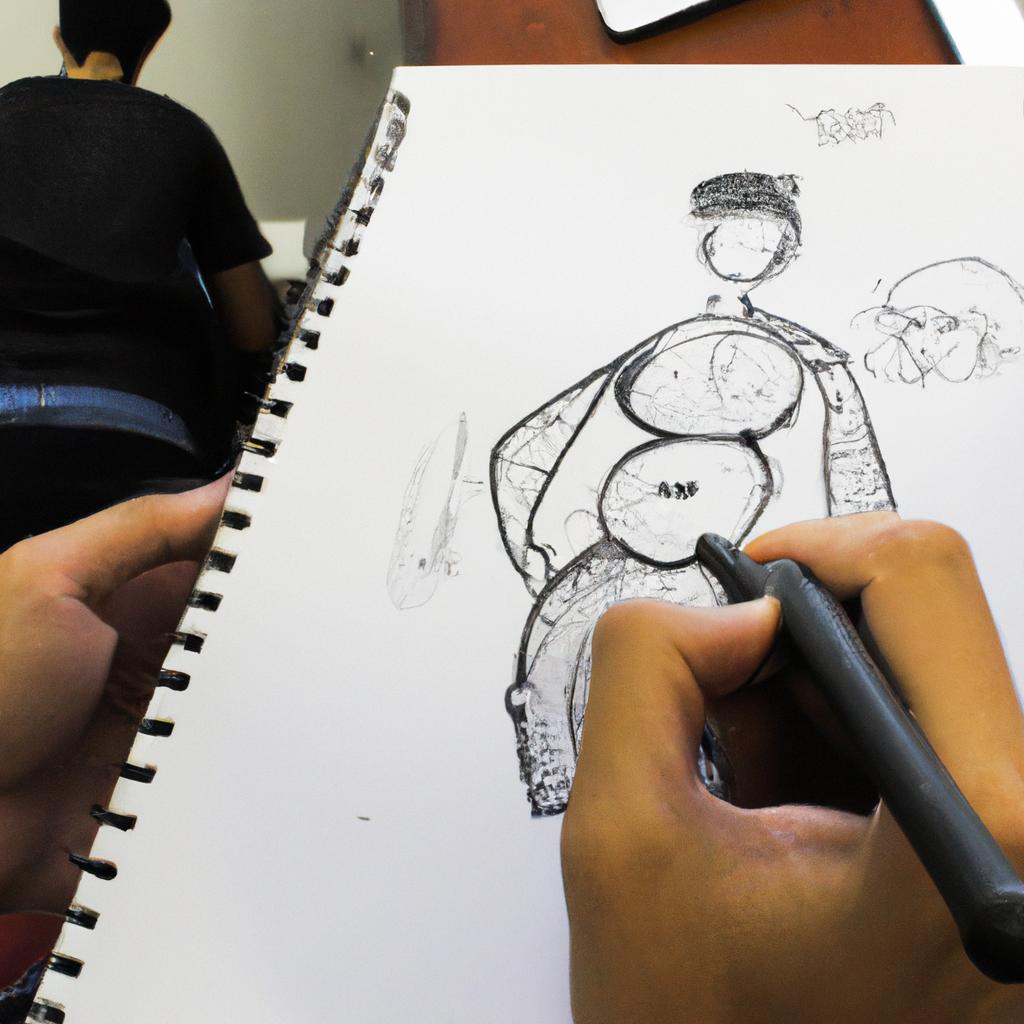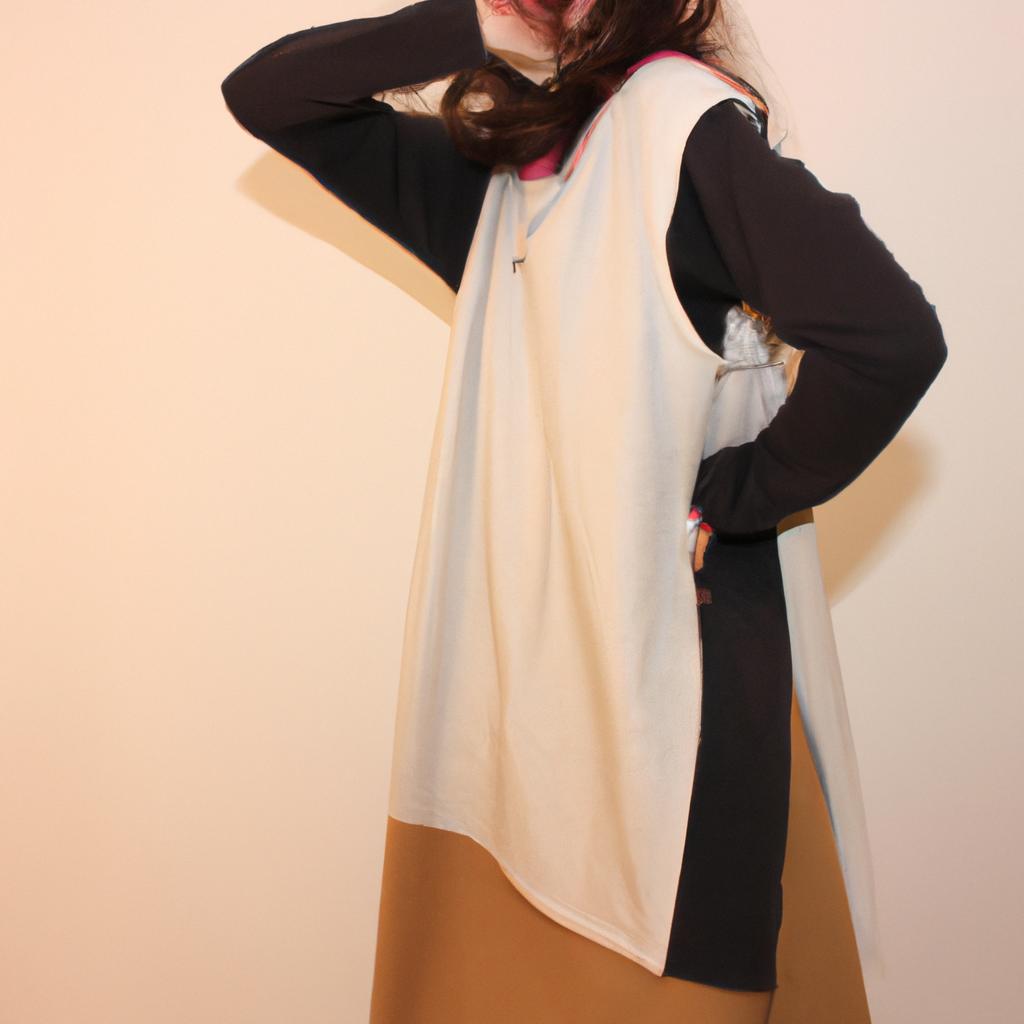Clothing and costume design play a pivotal role in the realm of arts and illustration, particularly when it comes to character creation. The careful selection and arrangement of garments can effectively communicate a character’s personality traits, social status, historical context, or even their narrative arc. For instance, imagine a dystopian world where society is divided into distinct factions based on their attire. In such a scenario, clothing becomes not only an aesthetic choice but also a powerful tool for storytelling and world-building.
This guide aims to explore the intricate process of clothing and costume design within the context of arts and illustration. By delving into various techniques, principles, and considerations involved in creating compelling characters through their attire choices, this article seeks to equip artists with valuable insights for enhancing their character design skills. Through examining real-life case studies or hypothetical examples alike, readers will gain an understanding of how meticulous attention to detail in clothing design can contribute to the overall impact and success of visual storytelling projects.
In the subsequent sections of this article, we will discuss different aspects related to clothing and costume design in arts and illustration. This includes exploring the significance of color theory in conveying emotions or symbolism through apparel choices; analyzing the influence of historical fashion trends on contemporary character designs; examining cultural appropriation versus appreciation ; discussing the importance of considering practicality and functionality in costume design for action-oriented characters; and exploring the role of clothing in expressing identity, gender, and power dynamics.
Furthermore, we will delve into the process of researching and gathering visual references to inform clothing designs, as well as techniques for sketching, rendering, and finalizing costume concepts. We will also touch upon the use of digital tools and software that can aid in creating detailed and dynamic clothing designs.
To provide a comprehensive understanding of clothing and costume design in arts and illustration, we will draw insights from various sources such as fashion history, cultural anthropology, psychology, and storytelling methods. By examining these interdisciplinary perspectives, artists can approach character design with a more nuanced understanding of how clothing choices can enrich their narratives and evoke emotional responses from viewers.
Whether you are an aspiring illustrator or an experienced artist looking to expand your repertoire, this guide aims to serve as a valuable resource for enhancing your skills in clothing and costume design. So let’s embark on this creative journey together as we explore the captivating world of apparel aesthetics within the realm of arts and illustration.
The Importance of Clothing and Costume Design in Visual Storytelling
Imagine a visually captivating scene: a lone figure stands on a barren landscape, their tattered cloak billowing in the wind. The choice of clothing for this character not only adds visual interest but also conveys crucial information about their identity and the world they inhabit. This example illustrates the significance of clothing and costume design in visual storytelling, as it holds power to evoke emotions, establish cultural context, enhance character development, and immerse audiences in rich narratives.
Emotional response is an essential component of any successful visual story. By carefully selecting garments that resonate with viewers on an emotional level, designers can elicit specific reactions from the audience. A bullet point list below exemplifies how clothing choices can evoke different emotions:
- Bold colors and intricate patterns can convey vibrancy and excitement.
- Dark tones and somber textures may evoke feelings of melancholy or despair.
- Uniforms or well-tailored suits might imply authority or professionalism.
- Flowing fabrics and loose silhouettes can create a sense of freedom or ethereal beauty.
To further emphasize the impact of clothing design, consider the following table showcasing four characters from various eras along with their corresponding attire:
| Character | Era | Clothing Style |
|---|---|---|
| Elizabeth Bennet | Regency Period | Empire-waist gowns |
| Tony Montana | 1980s | Double-breasted suit |
| Katniss Everdeen | Post-Apocalyptic World | Functional hunting gear |
| Carmen Miranda | Golden Age of Hollywood | Exaggerated fruit headdress |
Each character’s dress clearly communicates important aspects such as social status, historical period, narrative setting, or even personality traits. Through these examples, we witness how costumes become integral elements contributing to the overall effectiveness of visual storytelling.
Understanding the role of clothing in expressing character personality will be explored in the subsequent section. By analyzing how different outfits reflect individual traits, designers can create characters that feel authentic and relatable to audiences. Through a careful combination of clothing elements such as color palettes, fabric choices, and style details, artists can breathe life into their creations and enhance the visual narrative they seek to convey.
Understanding the Role of Clothing in Expressing Character Personality
Building upon the importance of clothing and costume design in visual storytelling, it is crucial to understand how these elements contribute to the overall narrative. By examining their role through a character-centric lens, we can appreciate how clothing choices can enhance our understanding of the characters’ personalities and motivations.
Consider the case study of Sarah, a young artist struggling with her identity in a bustling city. She wears oversized, mismatched clothes that seem to reflect her feelings of being out-of-place. Through this deliberate choice, the audience gains insight into her introverted nature and her desire for self-expression within an environment where she feels overshadowed.
To delve deeper into the impact of clothing on character portrayal, four key points emerge:
- Symbolism: Clothing serves as a powerful visual tool to symbolize various aspects of a character’s personality or journey. For example, vibrant colors may represent optimism or confidence, while dark tones might suggest mystery or melancholy.
- Cultural Context: Understanding cultural norms and conventions allows designers to create authentic costumes that resonate with viewers. This attention to detail helps establish believability and facilitates better immersion within the story world.
- Historical Significance: Incorporating historical references adds depth and richness to costume designs by grounding them in specific time periods or events. Such details lend credibility to narratives set in particular eras while fostering interest among historically-minded audiences.
- Emotional Impact: Well-designed costumes have the ability to evoke emotions from viewers through color schemes, textures, and silhouettes. A flowing dress might elicit feelings of gracefulness or freedom, while armor can instill notions of strength and resilience.
To illustrate further how clothing design affects storytelling effectiveness, consider the following table showcasing different fictional characters alongside their respective outfits:
| Character | Outfit Description | Emotional Response |
|---|---|---|
| Emma | A tailored pantsuit and high heels | Confidence |
| James | Ripped jeans, band t-shirt, and leather jacket | Rebellion |
| Sophia | Flowing dress adorned with floral patterns | Elegance |
| David | Baggy hoodie, worn-out sneakers | Relatability |
In conclusion, clothing and costume design play a pivotal role in visual storytelling by enhancing character development and narrative immersion. By carefully considering the symbolism, cultural context, historical significance, and emotional impact of costumes, designers can effectively convey characters’ personalities and motivations to captivate audiences.
Moving forward into the next section on researching historical and cultural references for authentic costume design…
Researching Historical and Cultural References for Authentic Costume Design
Example: Let’s consider a scenario where an artist is tasked with designing costumes for a historical drama set in ancient Egypt. To create authentic and visually appealing outfits, it becomes essential to delve into the rich history and cultural nuances associated with this civilization.
In order to accurately depict clothing from a specific time period or culture, comprehensive research plays a pivotal role. By examining historical references such as archaeological findings, art pieces, and written accounts, designers can gain valuable insights into the materials used, garment construction techniques employed, and even the societal significance behind certain attire.
To better understand how historical and cultural factors influence costume design, let us explore some key aspects:
- Iconography: Symbols and motifs found in artwork or artifacts can provide inspiration for patterns or embellishments in costume design.
- Social hierarchy: Clothing often reflects social status within a particular society; understanding these hierarchies helps in creating accurate character portrayals.
- Climate and geography: Environmental conditions impact fabric choices, layering techniques, and overall practicality of garments.
- Rituals and traditions: Ceremonial practices may necessitate distinct wardrobe elements that convey religious beliefs or serve ceremonial purposes.
By incorporating these factors into their designs, artists can effectively capture the essence of different cultures throughout history while ensuring authenticity in their work.
| Factors Influencing Costume Design |
|---|
| Iconography |
| Social Hierarchy |
| Climate & Geography |
| Rituals & Traditions |
Understanding how historical context shapes clothing allows artists to breathe life into characters by dressing them appropriately according to their backgrounds. Next, we will further expand our exploration by delving into the various clothing styles and silhouettes that can enhance character design, providing an even deeper understanding of how garments contribute to persona development.
Exploring Different Clothing Styles and Silhouettes to Enhance Character Design
Building upon the foundation of historical and cultural references, exploring different clothing styles and silhouettes is crucial in elevating character design. By carefully selecting appropriate garments and shapes, designers can effectively convey personality traits, enhance visual storytelling, and captivate audiences. To illustrate this concept, let’s consider a hypothetical case study involving a character named Maya.
Maya is an adventurous archaeologist who travels the world in search of ancient artifacts. In order to visually communicate her intrepid spirit, it would be fitting for Maya to don utilitarian attire that reflects her practical nature while also paying homage to various cultures she encounters during her expeditions.
To achieve this goal, there are several key points to keep in mind:
-
Consider the time period: Researching specific eras or regions will help determine which clothing styles align with the character’s background and story. For example, if Maya uncovers relics from Ancient Egypt, incorporating elements of Egyptian fashion into her costume could establish a deeper connection between her character and the narrative.
-
Analyze body shape and proportions: Understanding how different cuts and silhouettes flatter or emphasize certain features allows designers to create well-balanced characters. By accentuating Maya’s strength through tailored jackets or loose-fitting cargo pants, her physicality becomes more evident to viewers.
-
Experiment with contrasting aesthetics: Combining unexpected clothing styles can add complexity and intrigue to a character’s appearance. Blending traditional tribal patterns with modern urban streetwear, for instance, may highlight Maya’s ability to adapt effortlessly across diverse environments.
-
Utilize symbolism through color choices: Colors evoke emotions and meanings that can further enrich character development. Incorporate hues that resonate with the desired mood or narrative arc—earthy tones like deep greens or browns may signify resilience or connection to nature for Maya as she traverses rugged landscapes.
By thoughtfully exploring different clothing styles and silhouettes, designers can effectively enhance character design, providing a visual language that resonates with audiences. As we move forward into the next section on using color and texture to convey mood and narrative in costume design, let’s further delve into how these elements contribute to creating compelling characters with depth and dimension.
Using Color and Texture to Convey Mood and Narrative in Costume Design
In the previous section, we delved into the importance of exploring different clothing styles and silhouettes to enhance character design. Now, let us further explore this topic by considering how color and texture play a crucial role in conveying mood and narrative in costume design.
To illustrate this point, imagine a fictional character named Lily. She is an adventurous archaeologist who travels through ancient ruins seeking hidden treasures. Her costume should reflect her bold personality while also being functional for her expeditions. By carefully selecting the right color palette and incorporating textures that evoke a sense of mystery and exploration, Lily’s costume can effectively convey her story even before she utters a single word.
When designing costumes with specific moods or narratives in mind, consider these key elements:
- Color symbolism: Utilize colors strategically to evoke certain emotions or associations within your audience.
- Texture juxtaposition: Experiment with combining contrasting textures to create visual interest and reinforce thematic elements.
- Historical references: Draw inspiration from historical fashion trends to add depth and authenticity to your characters’ costumes.
- Subtle details: Incorporate small but meaningful details that provide subtle hints about your character’s background or personality.
Aesthetic choices are subjective; however, they have the power to elicit emotional responses from viewers. For instance, when creating Lily’s costume as an adventurous archaeologist, imagine utilizing warm earth tones such as rusty browns and deep greens to invoke a sense of antiquity and connection with nature. Pairing rugged leather accents with delicate embroidery could symbolize both strength and elegance – qualities befitting an intrepid explorer.
By thoughtfully considering color palettes, textures, historical references, and subtle details in costume design, you can effectively communicate aspects of your characters’ personalities without relying solely on dialogue or explicit storytelling techniques.
Moving forward into our next section on practical tips for creating functional and believable costumes for characters, we will delve into the technical aspects of costume design. This includes considerations such as fabric choices, mobility requirements, and the importance of integrating practicality with aesthetic appeal to bring your characters to life in a tangible way.
Practical Tips for Creating Functional and Believable Costumes for Characters
In the previous section, we explored how color and texture can be powerful tools in conveying mood and narrative in costume design. Now, let’s delve into some practical tips for creating functional and believable costumes for characters.
To illustrate these tips, let’s consider the example of designing a costume for a fantasy film set in an enchanted forest. The character we will focus on is a mischievous woodland sprite named Willow.
-
Research: Begin by conducting thorough research on the world of your character. Explore different cultures, historical periods, or even nature itself to gather inspiration. For Willow, you may study folklore tales featuring sprites and examine the vibrant colors found in forests like mossy greens, earthy browns, and ethereal blues.
-
Functionality: While aesthetics play a significant role in costume design, it is equally important to ensure that the costumes are functional for both the actor wearing them and the character they portray. Consider factors such as ease of movement, weather conditions during filming, and any specific actions required by the character. In Willow’s case, lightweight fabrics with stretchability would allow her to move freely while still capturing her playful spirit.
-
Symbolism: Costumes often serve as visual symbols that convey information about a character’s personality or story arc. Utilize color symbolism to enhance storytelling through clothing choices; for instance, using warm tones to represent warmth and compassion or cool tones to evoke mystery or detachment. Additionally, textures like flowing silks could emphasize gracefulness while rougher materials might denote resilience or ruggedness.
-
Attention to Detail: Paying attention to small details can elevate a costume design from ordinary to extraordinary. Incorporate accessories like jewelry or props that align with your character’s background or interests. For Willow, delicate leaf-shaped earrings or bracelets made from natural elements could enhance her connection with nature.
By following these guidelines when creating costumes for your characters, you can enhance their visual impact and contribute to the overall storytelling of your project. Remember that costume design is an art form in itself, bringing characters to life through carefully chosen colors, textures, and attention to detail.
Table: Examples of Symbolic Colors in Costume Design
| Color | Meaning |
|---|---|
| Red | Passion, power |
| Blue | Calmness, mystery |
| Green | Nature, growth |
| Yellow | Joy, optimism |
Bullet Points: Emotional Impact of Well-Designed Costumes
- Evokes a sense of wonder and escapism
- Enhances believability and immersion in the story world
- Helps establish character identities and relationships
- Contributes to audience emotional connection with the narrative
Incorporating these techniques into your costume design process will not only create visually captivating characters but also enrich the storytelling experience for both the actors and the audience.
 PSP Oste
PSP Oste



